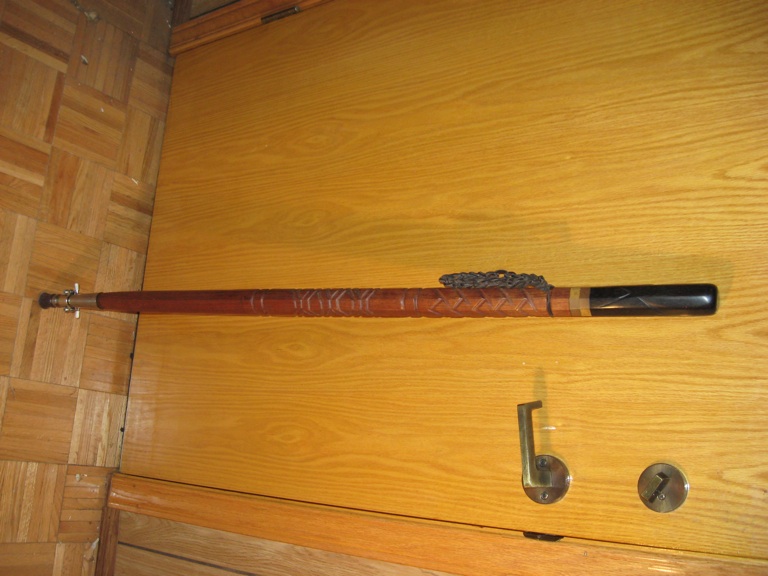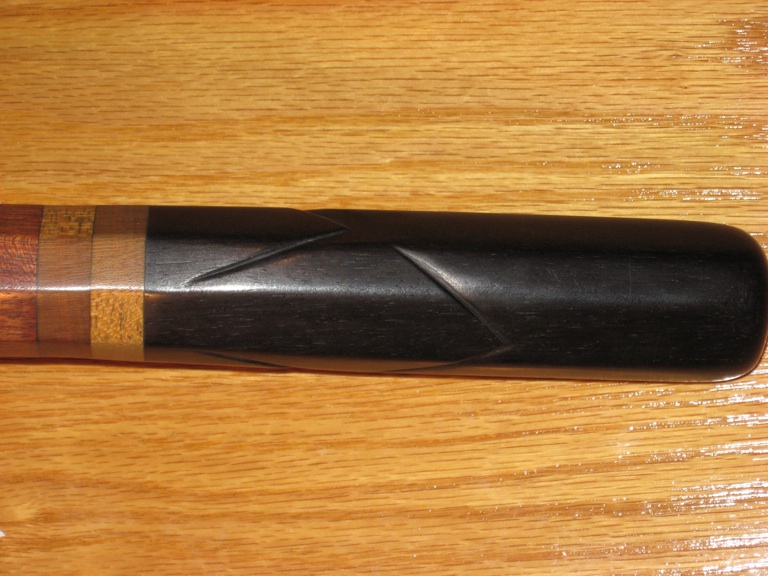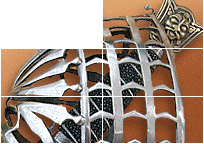| Author |
Message |
Eric G.

|
 Posted: Thu 29 Dec, 2011 9:08 pm Post subject: Hafting a Lutel Halberd Posted: Thu 29 Dec, 2011 9:08 pm Post subject: Hafting a Lutel Halberd |
 |
|
For Christmas my wife got me a Lutel Halberd =) I had been coveting it for some time. As many of you may know, Lutel sends the heads alone, so now I have the task of hafting it.
I have spent the evening reading old posts on how to attach it and I'm feeling pretty confident that I can do that part. My problem is finding an ashwood shaft.
I know that Kult of Athena has them for $24, but the problem is that shipping adds an extra $35... Home Depot didn't have anything but pine in lengths that are required for this. I went to a shop that has tons of specialty woods, but they only carried ash in boards.
So does anyone have an excellent suggestion for me? I was thinking of using my table saw to cut an octagonal shaft from an ash board. The table saw blade can be tilted to a 45 degree angle, so this shouldn't be too hard. However, if there is a better way I would appreciate the advice before I waste time and money.
Just FYI, the socket hole is 1.25 inches at the base, measured from the inside.
Thanks all.
Eric Gregersen
www.EricGregersen.com
Knowledge applied is power.
|
|
   |
 |
|
Bryan W.
|
 Posted: Thu 29 Dec, 2011 10:13 pm Post subject: Posted: Thu 29 Dec, 2011 10:13 pm Post subject: |
 |
|
http://www.woodenswords.com
I know purpleheart armory sells hickory staffs but its probably more expensive than KOA.
|
|
  |
 |
Alex Spreier

|
 Posted: Thu 29 Dec, 2011 11:05 pm Post subject: Posted: Thu 29 Dec, 2011 11:05 pm Post subject: |
 |
|
How long of a haft are you looking for? Sean Flynt has used replacement wheel-barrow handles, which are hardwood and about 60" long. Just FYI
Compagno, Northwest Fencing Academy
http://bunkaijuju.blogspot.com/
|
|
  |
 |
|
Timo Nieminen
|
 Posted: Fri 30 Dec, 2011 12:09 am Post subject: Re: Hafting a Lutel Halberd Posted: Fri 30 Dec, 2011 12:09 am Post subject: Re: Hafting a Lutel Halberd |
 |
|
| Eric Gregersen wrote: |
So does anyone have an excellent suggestion for me? I was thinking of using my table saw to cut an octagonal shaft from an ash board. The table saw blade can be tilted to a 45 degree angle, so this shouldn't be too hard. However, if there is a better way I would appreciate the advice before I waste time and money. |
Sounds OK. Need a thick board for that, though. Might work well enough to cut a rectangular haft, and then plane it octagonal. 1 board will give you a bunch of hafts, so you'll have some spares.
My upcoming polearms project is to make some laminated hafts. Glue 4 6mm thick boards together, maybe drill and glue in bamboo pins where butt pieces and head fittings won't help hold it together. Get a basic rectangular haft, and plane to shape and size. I want 4-6 oval section hafts.
"In addition to being efficient, all pole arms were quite nice to look at." - Cherney Berg, A hideous history of weapons, Collier 1963.
|
|
   |
 |
Eric G.

|
 Posted: Fri 30 Dec, 2011 5:23 am Post subject: Posted: Fri 30 Dec, 2011 5:23 am Post subject: |
 |
|
Thanks guys for you suggestions.
| Alex Spreier wrote: | | How long of a haft are you looking for? Sean Flynt has used replacement wheel-barrow handles, which are hardwood and about 60" long. Just FYI |
I remember that, now that you mention it. I was under the impression that a Halberd should be a bit longer, like around 6 or 7 feet rather than 5. Is that right?
Also, I know that Arms and Armor uses ash, but as Bryan mentioned, purple heart sells hickory staffs. What woods are ok?
Eric Gregersen
www.EricGregersen.com
Knowledge applied is power.
|
|
   |
 |
|
M. Livermore
|
|
  |
 |
James Barker

Location: Ashburn VA Joined: 20 Apr 2005
Posts: 365
|
 Posted: Fri 30 Dec, 2011 6:43 am Post subject: Posted: Fri 30 Dec, 2011 6:43 am Post subject: |
 |
|
Have access to a table saw? I ripped several shafts from one ash board from a hardwood lumber yard for about $20. I have a pole arm and three spears made off the same board. If you want it round rip it down to a hex shape then use a hand plane, electric plane, palm sander, or combo of all of these. My Lutel pole arm is on a square shaft:
My back is to the camera here:

James Barker
Historic Life http://www.historiclife.com/index.html
Archer in La Belle Compagnie http://www.labelle.org/
|
|
   |
 |
|
Matthew Kelty
|
 Posted: Fri 30 Dec, 2011 9:58 am Post subject: Posted: Fri 30 Dec, 2011 9:58 am Post subject: |
 |
|
Eric, I was in the same boat trying to make pikes, and opted for doing it myself. My local full-service lumber specialty store had the ash. The first time I did all the ripping myself, the second time, I had them rip them to squares, and I did the octagonals (a 45 degree pass and then a 22.5 degree pass).
I was after a huge volume (a dozen pikes) and it made sense financially across that number. Especially considering I burned out a table saw ripping the beam myself... 
If I have any advice to ripping a beam yourself, it would be to have several long, large screwdrivers on hand, in case the grain and twist of the wood try to clamp it shut on you after the blade has passed.
|
|
    |
 |
Eric G.

|
 Posted: Fri 30 Dec, 2011 11:11 am Post subject: Posted: Fri 30 Dec, 2011 11:11 am Post subject: |
 |
|
| James Barker wrote: | | Have access to a table saw? |
| Eric Gregersen wrote: | | I was thinking of using my table saw to cut an octagonal shaft from an ash board. The table saw blade can be tilted to a 45 degree angle, so this shouldn't be too hard. |
As it just so happens, I do. Thank you for letting me know that this would work. It seemed like it would, but I am not expert at this, so there could have been problems that I did not anticipate.
| Matthew Kelty wrote: | The first time I did all the ripping myself, the second time, I had them rip them to squares, and I did the octagonals (a 45 degree pass and then a 22.5 degree pass).
If I have any advice to ripping a beam yourself, it would be to have several long, large screwdrivers on hand, in case the grain and twist of the wood try to clamp it shut on you after the blade has passed. |
Thanks for the extra little tips. It's this kind of stuff that will keep me from screwing it up.
To all,
I am under the assumption that the halberd should be between 6 and 7 feet. Is that right?
Eric Gregersen
www.EricGregersen.com
Knowledge applied is power.
|
|
   |
 |
Jean Thibodeau

|
 Posted: Fri 30 Dec, 2011 3:08 pm Post subject: Posted: Fri 30 Dec, 2011 3:08 pm Post subject: |
 |
|
| Eric Gregersen wrote: | | James Barker wrote: | | Have access to a table saw? |
| Eric Gregersen wrote: | | I was thinking of using my table saw to cut an octagonal shaft from an ash board. The table saw blade can be tilted to a 45 degree angle, so this shouldn't be too hard. |
As it just so happens, I do. Thank you for letting me know that this would work. It seemed like it would, but I am not expert at this, so there could have been problems that I did not anticipate.
| Matthew Kelty wrote: | The first time I did all the ripping myself, the second time, I had them rip them to squares, and I did the octagonals (a 45 degree pass and then a 22.5 degree pass).
If I have any advice to ripping a beam yourself, it would be to have several long, large screwdrivers on hand, in case the grain and twist of the wood try to clamp it shut on you after the blade has passed. |
Thanks for the extra little tips. It's this kind of stuff that will keep me from screwing it up.
To all,
I am under the assumption that the halberd should be between 6 and 7 feet. Is that right? |
I've done this myself, but with a walking stick: Had the lumber yard cut up a plank into squares and then planed them octagonal: Not as long as a polearm haft but on the other hand the wood was extremely hard Macassar Ebony and the job was done by hand planing, no power tools, lots of patience and eyeball .....   
As to long and thick poles I found some very thick diameter ones, at a local to me, speciality wood suppliers: Mostly up to
1 1/2" diameter Ash or " mystery " hardwood as the lumber yards at times don't identify the woods they use to make dowels.
I haven't bought one yet, but at the same wood supplier there are 1 3/4" diameter White Oak poles up to 10' long that are for staircase railings: You might look into lumber suppliers that offer these very oversized poles that you could also taper in interesting ways. 
Pics are of another stick I made recently: The main shaft is Jatoba and was 1 1/2" square, planed octagonal and then carved with files, top end is African Ebony and even harder than the Macassar Ebony.
Anyway, the point being that even though the piece is a lot shorter to work on than for a Halberd haft the woods are about 3 to 4 times harder than Ash or White Oak and the wood for your halberd would be much easier and faster to work.
But if you can do the making octagonal with power tools you would be able to make it round if you wish with rasps fairly easily and finish with finer and finer grits of sanpaper.
 Attachment: 124.43 KB Attachment: 124.43 KB

 Attachment: 128.44 KB Attachment: 128.44 KB

 Attachment: 148.52 KB Attachment: 148.52 KB

 Attachment: 219.69 KB Attachment: 219.69 KB
[ Download ]
You can easily give up your freedom. You have to fight hard to get it back!
|
|
  |
 |
|
Bryan W.
|
 Posted: Fri 30 Dec, 2011 6:10 pm Post subject: Posted: Fri 30 Dec, 2011 6:10 pm Post subject: |
 |
|
|
Not to hijack the thread but Jean if you made that........great work!
|
|
  |
 |
|
D. Phillip Caron
|
 Posted: Fri 30 Dec, 2011 7:53 pm Post subject: Posted: Fri 30 Dec, 2011 7:53 pm Post subject: |
 |
|
Eric, we have a wonderful wood in this country. The French called it "Bow Wood". The indians used it for bow making. Find a "Horse Apple" tree and pick your piece. They may not grow in your area, but they are all over the east. It's tough as your father, and flexible as your grandfather's memory.
The first casualty of battle is bravado, the second is macho.
|
|
  |
 |
Jean Thibodeau

|
 Posted: Fri 30 Dec, 2011 7:55 pm Post subject: Posted: Fri 30 Dec, 2011 7:55 pm Post subject: |
 |
|
| Bryan W. wrote: | | Not to hijack the thread but Jean if you made that........great work! |
Thanks, and yes I made it. 
And yes lets not hijack the thread as I mostly wanted to show that one can get from square to octagonal with hand tools if one is patient and persistent, and from octagonal to round is even easier. 
Oh, one can also use a spokeshave which is like a cross between a plane and a drawknife but with more control over the depth of cut than a drawknife that can be too aggressive and risks digging in too deep if one isn't careful.
http://en.wikipedia.org/wiki/Spokeshave
http://en.wikipedia.org/wiki/Drawknife
Note these tools are also really useful in tapering a haft to fit into a spear or polearm socket.
You can easily give up your freedom. You have to fight hard to get it back!
|
|
  |
 |
|
D. Phillip Caron
|
 Posted: Fri 30 Dec, 2011 8:01 pm Post subject: Posted: Fri 30 Dec, 2011 8:01 pm Post subject: |
 |
|
Additional thought; do NOT use a saw on the wood you use as the staff. Use a natural limb. Split it like Ole Abe did, then use wood working hand tools. The grain adds immense strength to the shaft. Do it like they did way back when.
The first casualty of battle is bravado, the second is macho.
|
|
  |
 |
Jean Thibodeau

|
 Posted: Fri 30 Dec, 2011 8:10 pm Post subject: Posted: Fri 30 Dec, 2011 8:10 pm Post subject: |
 |
|
| D. Phillip Caron wrote: | | The French called it "Bow Wood". |
Being French Canadian I would call it " Bois D'Arc ".  
Or AKA Osage Orange.
http://en.wikipedia.org/wiki/Maclura_pomifera
You can easily give up your freedom. You have to fight hard to get it back!
|
|
  |
 |
Eric G.

|
 Posted: Fri 30 Dec, 2011 8:21 pm Post subject: Posted: Fri 30 Dec, 2011 8:21 pm Post subject: |
 |
|
Jean,
That its absolutely amazing, and no worries, you absolutely did not hijack the thread. I honestly think that your staff looks very nice. And I really appreciate the advice. This joint is wonderful for ask the knowledgeable people.
| D. Phillip Caron wrote: | | Additional thought; do NOT use a saw on the wood you use as the staff. Use a natural limb. Split it like Ole Abe did, then use wood working hand tools. The grain adds immense strength to the shaft. Do it like they did way back when. |
I appreciate that advice, but the problem is that I live in Arizona. In my area we have palm trees (which are ugly and worthless for giving shade) mesquite trees, and saguaro... Northern AZ has a lot of pine... Worthless. I do know a guy that makes some really nice bows. I will ask him before I go rip a board on a table saw.
Eric Gregersen
www.EricGregersen.com
Knowledge applied is power.
|
|
   |
 |
|
D. Phillip Caron
|
 Posted: Fri 30 Dec, 2011 8:33 pm Post subject: Posted: Fri 30 Dec, 2011 8:33 pm Post subject: |
 |
|
It seems a simple thing, but fact is, hand tools on wood give a stronger product. A saw is destructive to strength. If you talk to that person about bow making you will get a lesson on weapons making.
The first casualty of battle is bravado, the second is macho.
|
|
  |
 |
Jean Thibodeau

|
 Posted: Fri 30 Dec, 2011 9:25 pm Post subject: Posted: Fri 30 Dec, 2011 9:25 pm Post subject: |
 |
|
| D. Phillip Caron wrote: | | It seems a simple thing, but fact is, hand tools on wood give a stronger product. A saw is destructive to strength. If you talk to that person about bow making you will get a lesson on weapons making. |
Using a small strait tree would be ideal if one could find one of the right type of wood and have access to it to cut down: A trunk or a limb has perfect alignment of the grain and it's all in concentric circles.
Second best is a plank chosen and cut with the grain as strait as possible since grain running at an angle rather than lengthways to the haft will be more fragile and prone to spilt along the grain or warp.
You can easily give up your freedom. You have to fight hard to get it back!
|
|
  |
 |
|
|

